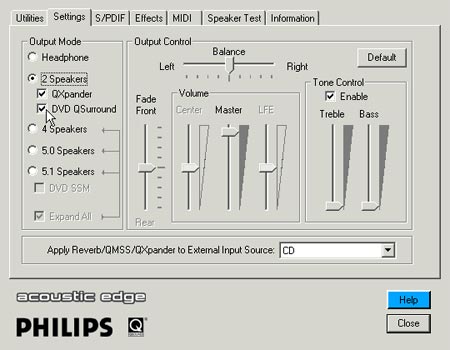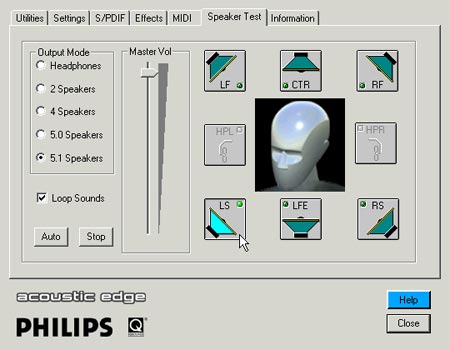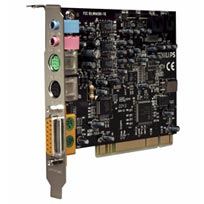What would a sound card be without a handful of acoustic
technology to improve the level of gaming or DVD playback we have come to expect
from non-integrated audio chipsets? Add to that the problem of what to do when
you don't have a 5.1 speaker system and you will find the Acoustic Edge has some
very clever solutions.
Of particular interest is Philips signal processing
algorithm, QMSS. The QMSS algorithm analyzes two stereo channels, extrapolates a
trajectory and pan for the sound (say if a train is moving from front to back)
and provides distinctly different sounds to each speaker respectively. This
distributed sound allows the card to emulate a true 5.1 acoustical setup with
pretty damn fine results. While playing those great FPS games we all know and
love, QXpander comes into its own and adds additional 3D enhancement. Stereo
sound is augmented by the QXpander algorithm and basically gets a 3D sound put
to it - even if it is really just 2D. It works well with movies, but I found the
effect to be less than ideal while listening to music - like distortion
at a concert.

Software controls allow the user to modify the
properties of the Acoustic Edge depending on the type and complexity of the
speaker system they may be using. Best of all, if you find QXpander to be
mucking around with the sound in a way you don't like, it can easily be shut
off.
Before setting up your speakers and sitting back to play
a rough and tumble game of QIII, it is a good idea to test out the sound
and find the ideal setup. The Speaker Test menu allows the user to test each and
every channel of the system to ensure proper sound levels, and placement in the
room. The system plays a sound that makes its way around the each of the
speakers in a clock-wise way so that you can sit down and make adjustments with
out needing to fiddle with the computer constantly.

DVD excels with the Acoustic Edge thanks to a built-in
Dolby Digital 5.1 decoder. What more could you really ask for? :-) In our case,
we dropped in the Matrix and hooked up the Acoustic Edge to our Logitech
SoundMan Xtrusio DSR-100's and blasted away at full tilt.
The Xtrusio is a 4-channel system so it gave us the
opportunity to test out Philips QMSS system to replicate 5.1 audio. True to
form, the audio emanating from each of the speakers was slightly varied, and
gave added life to the entire experience. The maximum output from the S/PDIF on
the Acoustic Edge is 48kHz, which is also the maximum digital sample rate it can
process. This is pretty standard among consumer sound cards which need only deal
with CD's that us 44kHz sample rates, and DVD's that use 48kHz.
With its sexy black PCB and powerfully adaptable sound
system the Acoustic Edge has managed to impress us at every turn. Add to that
the useful set of bundled software which includes Siren Xpress - a simplified
version of Siren Jukebox - which enables the user to manage their audio, and
even rip their own CD's, and you have an even more impressive offering.
As with any product which exists entirely in the acoustic
realm, it is difficult to present to you words that accurately describe the full
capabilities of the product. Rest assured, the 5.1 channel Acoustic Edge PSC706
is a worth buy, and one sound card we are happy to use everyday.

